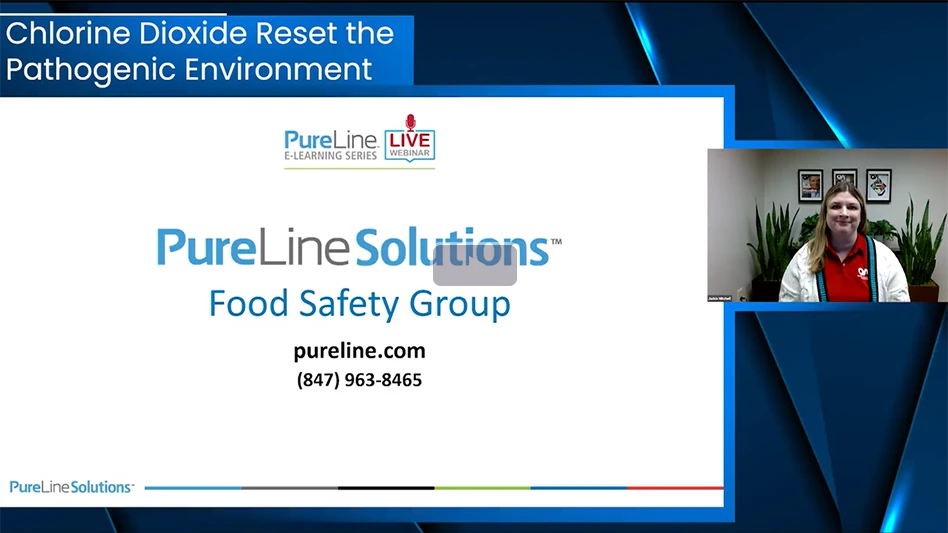
By Lisa Lupo
Flies are commonly considered to be nuisance pests, but in a food facility, these pests can be of significant risk. “Whether it is the transference of E. coli O157:H7 via a fruit fly or Salmonella enteritidis by a house fly, the potential for product and process contamination for food processors and related foodborne illness should not be discounted,” said Insect-O-Cutor President Jack Harris. “With filth flies being unwelcome guests in food processing facilities, one should be as inhospitable as possible to these pests.” But what is meant by “filth flies”? And what exactly does the food facility do to be “inhospitable”?
Four of the most common fly pests in food facilities are the relatively large house fly and the small fruit, phorid, and moth (drain) flies. Following are overviews of each of these and what food processing facilities can do for prevention and control.
THE HOUSE FLY

Because the house fly lives in close association with people, it is one of the most commonly encountered pests around the globe, said MGK Animal Health Technical Field Specialist Cassie Krejci. “House flies represent a serious health threat in food processing facilities as they are capable of mechanically transmitting numerous foodborne pathogens that cause disease.”
Prevention. “House flies are strong fliers and can enter a clean facility through an open entry point and with the help of negative air pressure from the building,” said Syngenta Professional Pest Management Technical Services Manager Nicky Gallagher. Other areas that allow house flies to enter a facility can include weep holes, wall voids, and dumpster chutes with poor sealants. Thus, house fly prevention should include:
- Installing effective window and door screens, opening doors only when necessary, installing air doors on frequently used entry points, and setting fly lights to trap flies that get through.
- Inspecting incoming shipments that could transport fly eggs and larvae.
- Removing all organic materials in potential breeding sites.
- Regularly cleaning garbage cans; placing trash in sealed garbage bags; and locating garbage receptacles as far from building entrances as possible.
Control. “Removal of breeding sites is a key component of a fly program,” Gallagher said. Critical areas should be cleaned frequently to reduce food sources or breeding sites.
Additionally, Krejci recommended indoor and outdoor applications of insecticides labeled for food processing facilities. This would include space spraying of indoor areas where flies rest (avoiding contact with exposed food and food handling surfaces) and outdoor applications in fly-resting areas. “Products that include an insect growth regulator (IGR) will provide additional control over future generations of house flies,” she said.
Indoor maintenance also can be completed with spot or crack or crevice treatments, and exterior granular fly baits can provide control in bait stations or as a broadcast treatment.
Other building-related controls, which may not seem obvious, include reducing the structure’s insect attractants, primarily that of lighting, for both the interior and exterior, Harris said. Examine the light-output spectrum of your fixtures; only those with little or no insect-attracting wavelengths (UVA) should be used on or around the facility’s exterior. The same consideration should be applied to interior lighting, though factors such as color indexing and intensity may take precedence.
If lighting with insect-attracting wavelengths is used inside the facility, as is sometimes necessary to achieve optimal operational light output, any errant light emissions to the outdoors should be minimized by placing the lighting so as to reduce direct outward emissions, he said. “And in a nod to efficiency, timers and activation sensors can greatly reduce continuous errant-light emissions from a facility’s interior lighting while reducing operational costs.”
THE FRUIT FLY

iStock
Technicians often must conduct lengthy inspections to find the source of a fruit fly infestation.
Prevention. “Fruit flies breed in drains, garbage disposals, trash cans, and other like areas,” Krejci said, adding, “Preventing a fruit fly infestation is as simple as eliminating the source.”
However, finding the source is not always as simple, as eggs are easily transported into facilities with food deliveries, and adults can enter through door and window screens, Gallagher said. “Technicians are often tasked with conducting lengthy inspections to find the source of the infestation.”
Control. Once a fruit fly infestation is established, control starts with locating any potential food source and removing it. A single piece of produce that may have fallen behind a shelf can be the source of an infestation, so thorough inspections of the facility are important, Krejci explained.
Fruit fly traps can help with monitoring or control, and adult fruit flies can be controlled with space sprays. However, Gallagher said, “It is essential to locate and eliminate breeding sites. This can be a challenge, but taking time to conduct thorough inspections and consistently communicate with facility personnel to discuss their role in fruit fly prevention can result in long-lasting control.”
Control also should include:
- Drain cleaning with a stiff brush and an anti-microbial foaming agent. Some IGRs also can be used to treat drains.
- Deep cleaning of decaying matter found on the underside of drain covers, caulk lines, backs of appliances (like ice machines and dishwashers), and dark corners.
- Space spraying in approved areas with an adulticide and treating landing zones with insecticides, taking care to never treat food-contact surfaces.
THE PHORID FLY

Phorid flies are small in size but can mechanically spread bacteria to food and food-contact surfaces from the outdoors, Krejci said. Frequently found around garbage, drains, damp organic waste, and rotting produce, phorid flies also can bring pathogens into a facility after breeding in dead animals. “Because they feed in decaying debris, feces, floor drains, and such, phorids are suspected of carrying Salmonella, E. coli, and similar pathogens to food and food-contact surfaces,” said Industry Consultant Mike Holcomb. “Their presence in food plants or conditions favorable to their activity is a serious find for food inspectors.”
Additionally, he said, the fly larvae go through a wandering phase and leave the food source to pupate in a safe/hidden place, so the first signs of activity can be the adults, the wandering larvae, or the pupal cases — in some unexpected places. Because of that, “outside the box” thinking can be most effective for controlling this pest in food plants and warehouses, he said.
Prevention. Holcomb provided the example of phorid fly pupae found inside the electrical plug of a portable scale in a plant’s packaging department. Even though the manufacturer produced low-moisture dog treats, equipment was wet cleaned weekly. When the equipment plug was dismantled, small deposits of airborne food particles (fines), water overspray from sanitation, and fly pupae were found inside. The plant sanitarian had this rickety “resource site” replaced with a new water-tight plug designed for use in wet processing areas, Holcomb said.
In another facility, a phorid fly pupa case was found attached beneath the lid of a rodent trap by a third-party auditor, who cited the food facility for not properly maintaining the pest control equipment, Holcomb said. According to the site’s IPM program, internal rodent devices were to be serviced/maintained weekly, so the auditor’s contention was that since the phorid fly completes its development (egg to adult) in two to four weeks, the presence of an empty pupa case indicated that the station was not cleaned weekly. Further, it strongly indicated that a mouse had died in the rodent trap — but none had been written into the technician’s service report. It was circumstantial evidence, but strong enough to discredit the pest control company.
Control. “Accurate identification is the first and most important step of any fly control program,” Gallagher added. “If the fly is not accurately identified, the treatment process may not match the biology and behavior.” Phorid fly control may involve tearing into walls, repairing septic systems and leaking pipes, and removing contaminated soil or organic material. “When no apparent food source can be located, some established populations can continue the life cycle completely underground, with adult phorid flies finding their way into buildings through cracks and joints,” Gallagher said. For instance, sewage accumulating under slabs can create a vast resource for phorid fly breeding. Check for broken septic lines or cracked septic tanks, especially in older buildings.
“Cracks in plumbing, expansion joints, and windows are possible entrance points for phorid flies and should be repaired,” Krecji agreed. As with all small-fly infestations in food processing facilities, cleaning and maintenance of drains, removal of excessive moisture, and applications of insecticides and IGRs are important pillars of control.
THE MOTH/DRAIN FLY

Moth flies, also commonly called drain flies, are considered to be likely mechanical vectors of bacterial pathogens, as they are covered in fine hairs and scales, Krejci said. For their development, moth flies rely on standing water that is ripe with organic matter, and they ofetn are associated with high indoor humidity.
Because they originate in filthy conditions, moth flies can transmit bacteria and other microbes, Gallagher said. Adults also can be a problem by falling into food or getting in people’s eyes and mouths, and they commonly aggregate around windows, toilets, and other moist areas.
Prevention. To help prevent drain flies, keep indoor areas dry and free of excessive moisture, Krejci recommended. Clean wet areas often, paying special attention to toilets, water-holding tanks, drains, and sinks.
“The most effective way to prevent moth fly infestations is to eliminate organic, rotting material that they breed in,” Gallagher said. Clean drain pipes, drain traps, and other plumping components to eliminate the breeding sites often found in these areas. “Enzyme cleaners designed for use around plumbing sites are ideal for breaking down these kinds of bacteria,” he said.
Control. Control of moth flies is similar to that of fruit flies with removal of breeding sites as the first pillar of control, Krejci said. Landing areas in a food processing facility, such as the walls behind counters, can be treated with an approved adulticide, and using insecticides that are microencapsulated may provide a long residual, she said. “As with all fly infestations, use of an IGR is an important step to controlling future generations.”
FINAL FLY ADVICE
“Fly control can take time, persistence, and attention to detail,” Gallagher said, “But communication is also important.” If employees see a fly problem, they should report it as soon as possible, and honest communication from facility personnel about new infestation sightings, or even re-infestations, is imperative for a swift resolution.
Additionally, Krejci said, effective monitoring is essential to the success of an integrated pest management program in food processing. “For the past 30 years, much has been written about pest monitoring and sampling with sticky traps in structural environments,” she said. “However, pest control companies may not be maximizing the value of monitors, as monitors are often abandoned after the pest is identified.” Moving the monitors around the facility can pinpoint the exact location of the infestation or entry point, and control measures can be deployed more effectively, she said.
For both monitoring and control of any flying insect, facilities also should consider the use of insect light traps (ILTs), Harris said. As lighting fixtures that employ ultra-violet, insect-attracting lamps, ILTs are a means of mechanical control. Insect light traps are typically installed:
- At immediate entry points like loading docks where there is no direct exposure to open product, process, and related items.
- Along an insect’s most probable path from entry towards critical areas where easy contamination could occur.
- Within production areas (but not over exposed food or food-contact areas) to act as both a last mechanical control device and a monitoring device.
“Should a phase-three monitoring unit experience increased insect-catch activity, then facility personnel or responsible contractors should be made aware of this pest pressure to identify and eliminate this risk,” Harris said. (For more information on ILTs, see Reading the Message Your ILT is Relaying.)
Post-treatment monitoring of flies in food processing facilities is also important, Krejci said. Use traps to count the population and make sure it is declining. Control should be gained within several days if all resting, breeding, and feeding sites are treated. If it’s not, she said, re-inspect to make sure all relevant areas have been cleaned and treated. “If necessary, expand inspection area to other nearby sources of infestation,” Krejci said. “It is important to talk with employees of the food processing facility to make sure all sanitation and exclusion recommendations are being followed.”
The author is Editor of QA magazine. She can be reached at llupo@gie.net.

Explore the March 2019 Issue
Check out more from this issue and find your next story to read.
Latest from Quality Assurance & Food Safety
- Kim Heiman Elected to Second Term as President of Wisconsin Cheese Makers Association
- FAO Launches $150 Million Plan to Restore Ukrainian Agricultural Production
- Pet Food Company Implements Weavix Radio System for Manufacturing Communication
- Penn State Offers Short Course on Food Safety and Sanitation for Manufacturers
- USDA Announces New Presidential Appointments
- FDA to Phase Out Petroleum-Based Synthetic Dyes in Food
- IFT DC Section to Host Food Policy Event Featuring FDA, USDA Leaders
- CSQ Invites Public Comments on Improved Cannabis Safety, Quality Standards





